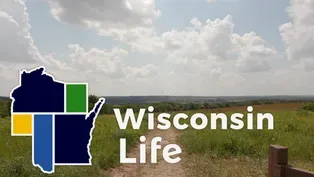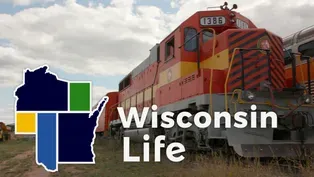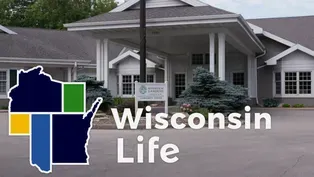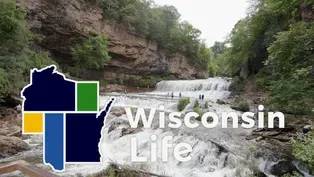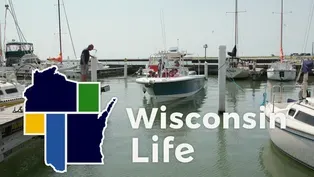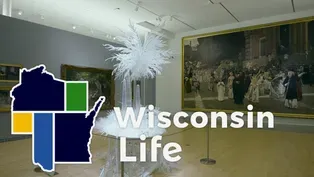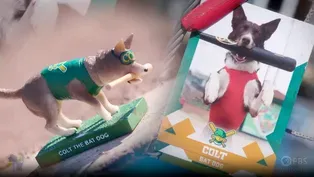
Holi Festival of Colors in Wausau
Season 10 Episode 1 | 26m 49sVideo has Closed Captions
We celebrate the Holi Festival of Colors at the Monk Botanical Gardens in Wausau.
Angela Fitzgerald enjoys dancing and food at the Holi Festival of Colors at the Monk Botanical Gardens in Wausau. We also meet a pair of bat dogs for Madison Mallards and Lake Country DockHound baseball games, a Milwaukee artist inspired by lakeshore trash, and a UW-Madison law professor encouraging young people to be more civically engaged.
Problems with Closed Captions? Closed Captioning Feedback
Problems with Closed Captions? Closed Captioning Feedback
Wisconsin Life is a local public television program presented by PBS Wisconsin
Funding for Wisconsin Life is provided by the Wooden Nickel Fund, Mary and Lowell Peterson, A.C.V. and Mary Elston Family, Obrodovich Family Foundation, Stanley J. Cottrill Fund, Alliant Energy, UW...

Holi Festival of Colors in Wausau
Season 10 Episode 1 | 26m 49sVideo has Closed Captions
Angela Fitzgerald enjoys dancing and food at the Holi Festival of Colors at the Monk Botanical Gardens in Wausau. We also meet a pair of bat dogs for Madison Mallards and Lake Country DockHound baseball games, a Milwaukee artist inspired by lakeshore trash, and a UW-Madison law professor encouraging young people to be more civically engaged.
Problems with Closed Captions? Closed Captioning Feedback
How to Watch Wisconsin Life
Wisconsin Life is available to stream on pbs.org and the free PBS App, available on iPhone, Apple TV, Android TV, Android smartphones, Amazon Fire TV, Amazon Fire Tablet, Roku, Samsung Smart TV, and Vizio.
Providing Support for PBS.org
Learn Moreabout PBS online sponsorshipMore from This Collection
Blackhawk Ski Club in Middleton
Video has Closed Captions
We explore the competitive side of winter sports with the Blackhawk Ski Club in Middleton. (26m 48s)
Retzer Nature Center in Waukesha
Video has Closed Captions
Angela visits the wild side of Waukesha at the Retzer Nature Center and planetarium. (26m 48s)
Wisconsin Great Northern Railroad in Trego
Video has Closed Captions
All aboard the Wisconsin Great Northern Railroad for a historic ride in the Northwoods. (26m 48s)
Video has Closed Captions
We tour Riverview Gardens in Appleton, a non-profit offering job training and employment. (26m 48s)
Willow River State Park in Hudson
Video has Closed Captions
Explore Willow River State Park’s stunning waterfall, serene lake and endless trails. (26m 48s)
Sailing Education Association of Sheboygan
Video has Closed Captions
We learn about adaptive sailing with SEAS, the Sailing Education Association of Sheboygan. (26m 48s)
Museum of Wisconsin Art in West Bend
Video has Closed Captions
Celebrate artists in our state at MOWA, Museum of Wisconsin Art in West Bend. (26m 49s)
Providing Support for PBS.org
Learn Moreabout PBS online sponsorship- Announcer: The following program is a PBS Wisconsin original production.
[shimmery music] - Angela Fitzgerald: Coming up on W isconsin Life, a pair of pups fetching more than just Frisbees, an artist inspired by her eclectic lake shore finds, a law professor uplifting th e next generation of leaders, a tour guide and artist find inspiration in a mine.
It's all ahead on Wisconsin Life.
[inquisitive piano and gentle brass] ♪ ♪ - Funding for Wisconsin Life is provided by Lowell and Mary Peterson, Alliant Energy, donors to the Focus Fund for Wisconsin Programs, and Friends of PBS Wisconsin.
- Welcome to Wisconsin Life.
I'm Angela Fitzgerald.
We're celebrating Holi, the Festival of Colors, [energetic music] Hosted by the Indian Society of Central Wisconsin, a nonprofit dedicated to increasing awareness of South Asian and Indian cultures in the area.
This year's festivities are held at the Monk Botanical Gardens in Wausau.
The gardens offer a lush setting to enjoy Indian street foods, learn Bollywood dance moves, and send powdered colors flying through the air.
Holi is the Hindu festival celebrating divine love while signifying the triumph of good over evil.
It's a joyous jamboree, bringing the community together in a vibrant way.
We'll learn more about that meaning later on.
The festivities are just beginning.
But before we paint the town, let's head into our first story... [shimmery music] As we travel to Sussex to catch up with a trainer and two dogs who have found fame fetching more than just Frisbees.
- Kate Bucci: I don't think there's one in there, buddy.
Oh, my gosh, crazies!
I started training probably when I was maybe 16.
I'm coming, I'm coming.
At this point, I've probably worked at least 3,000 dogs in my career.
Go.
- But none quite like these two brothers.
- Come on, let's go.
Come on, come on, come on, come on, come on, come on, let's go!
♪ ♪ Let's go!
Yeah!
These guys-- they're so much part of my everyday life.
Out.
Good job!
They're both border collies.
And these two very much enjoy being together.
And you can very much tell that they have that, like, brother bond.
- They've also bonded with their owner and trainer, Kate Bucci.
- I needed a strong, confident dog.
And I found Colt.
Yes.
Colt.
[whistles] Colt's just-- there's no fear of anything.
Kovu is more of the nerd.
He's more the goofy one.
Yes.
- Both are entertaining and fan favorites-- - Welcome to Warner Park here in Madison.
- For the Madison Mallards and Oconomowoc DockHounds.
- No, not our team.
Not our team.
We never bat first.
Hop up.
- These canines are ready for action.
- Get it.
- They're called "bat dogs."
- They're a lot quicker than the human bat boys.
[crowd cheers] The first time they go out and get a bat, there's a lot of cheering.
Get it.
By the time they hit the bat, they're hitting the brakes, and you'll see a lot of dust come up.
[laughs] Ooh, attaboy!
- Kate never intended to train Kovu and Colt as bat dogs.
- Come on!
- It just sort of happened.
- Come on, come on, come on!
It started when we did a seventh-inning stretch Frisbee thing.
And they said, "Do you think he can go fetch a bat?"
And I thought, "I think so."
I don't know; we never tried it.
Colt really didn't need a lot of training.
I showed him once, and he was good to go.
He'll look till he finds it.
Yeah.
Kovu needed a little bit more.
It's really just a big game of fetch.
Go find the object and come back with it.
- When they're on deck, the dogs are laser focused.
- Nope, not us.
Relax.
It's not us.
Colt is kind of like that serious marine where he's like, I have a job to do, and I'm doing it.
Nothing can distract me.
Kovu, on the other hand, was very much like, well, I'll do it, but I don't have the drive.
- No window.
Come on!
- But when he's bat dogging, he's very serious about that.
- The dogs have become a big hit.
[crowd cheering] - I just do it because they enjoy it.
It's never perfect.
They're dogs, and things happen.
Bats get thrown and different things.
- Kovu and Colt are all-stars.
With that notoriety comes baseball cards and bobbleheads.
- It's more popular than I probably think.
He sees cameras, and he's like, ooh!
And he poses, and he's very comical in his personality of being in the limelight.
Thank you.
- That fame isn't always easy for these hot dogs to handle.
Kovu, come on.
Fetching the bat is the very easy part.
The hard part for them to handle is the kids and dropping food on their head, that part of being a bat dog, being able to handle fans and noises.
- Baseball may be America's favorite pastime, but for Kate and her dogs, it's a big game of fetch.
- Oh, hang on.
I don't have it.
We've come so far.
And I've done stuff that I never even dreamed I would be doing.
There's such a connection that I have with these two.
It's hard to explain.
People who have a 'heart dog' will understand it.
And they're both very much my heart dogs.
[shimmery music] - Next up, we go to Milwaukee, where an artist finds inspiration in the sandy shores of Lake Michigan.
[waves crashing] [mellow music] - Geo Rutherford: That's why I love the lakes because I feel like they snuck up on me for the last 20 years of my life, and I wasn't expecting to fall in love with them.
And instead, it's kind of a long love story instead of a meet-cute... [laughs] ...or a short, instantaneous love at first sight.
♪ ♪ I guess I should say-- um, yes, hello-- my name is Geo Rutherford.
I am a printmaker, a book artist, and a educator, as well as a content creator on the internet.
♪ ♪ Geo Rutherford: Art became a really big interest for me in middle school and high school.
I took a printmaking class.
And actually, the first-ever print I made was horrendous.
And it made me so mad.
[laughs] I was, like, so upset that I was so bad at it that I just kept doing it.
And it became kind of an obsession for me.
I always made work about climate change, climate issues, environmental issues.
And that's a huge domain of artwork making.
[machines whir] I have about six prints that look like this where they're supposed to emulate the material on the shore.
We have the invasive Japanese lady beetle.
You have some freshwater snail shells.
You've got a button, a tampon applicator.
And it gets pushed up usually during storms.
So it ends up being this long line on the beach kind of pushed by the waves in these chunks and these patterns.
And so, this is kind of a artist's interpretation of those patches of beach finds.
[waves crashing] When you stand and look out at the Great Lakes, and you're on the shore, and the water is lapping at your feet, you have no idea the greater issues that the Great Lakes are facing.
You can't know that fr om just standing on the shore.
Ooh, tampon applicator!
Instead, you can pick through the sand and piece together a story of what's really happening with the Great Lakes through the material that you find, you know, on that precipice be tween the earth and the water.
You have plastic.
You have invasive plants, invasive species, invasive fish.
There's all sorts of stuff that gets turned over to the shore that I kind of end up collecting.
But it can be especially thrilling when you find something unexpected, like a tiny Barbie spoon or a little spider that's made of plastic.
I get so excited about that stuff, which is kind of unexpected.
I feel like most people don't get excited about disgusting beach trash, but I do.
This is the kind of thing I'm like, whoo-hoo!
Like, the best thing I've ever found.
[laughs] Isn't it gross?
I love her!
[laughs] I've done videos on all sorts of stuff with the Great Lakes.
My very first Great Lakes educational TikTok where I did not know what I was doing.
I didn't want my head to block the pictures I wanted to show.
So I put my face at the bottom, and I said, um, hello, yes.
Um, hello, yes.
Can we talk about this giant body of water hanging out in the middle of North America, please?
What an amazing place to make videos about because the Great Lakes have so many awesome topics.
I love the Stannard Rock Lighthouse.
Yes, hello, loneliest place in North America.
Did you say Stannard Rock Lighthouse in the middle of Lake Superior?
The Apostle Islands, the Pictured Rocks.
Why are there sand dunes in Michigan?
So many sand dunes.
Why are they there?
So I've done all sorts of videos about Great Lakes.
[popping] Even whitefish butthole, which is actually one of the most fascinating evolutionary topics that you can talk about with the Great Lakes-- I made a video on it.
I've got a really interesting story about whitefish and their buttholes.
Oh, my gosh!
I love spooky lakes.
And spooky lakes is another example of Geo just being like, man, what if I do this thing?
Um, yes, hello.
It's October 1st.
Do you know what that means?
It's spooky lake month, where we do 31 days of haunted hydrology.
I had all of these lakes that I realized are so spooky, just lakes that are radioactive or lakes that are made of salt, lakes that are acid, lakes that are made of lava.
There are so many weird lakes on this planet.
I talk about anything that's water-related that's spooky.
[waves crashing] People love the Great Lakes, and they're passionate about the Great Lakes.
And they're so excited that the word is out, that the Great Lakes are something that everybody can now be excited about.
And the Great Lakes are kind of this ultimate leftover of that time 10,000, 12,000 years ago.
So they are critical for our life here, the way that we've been living it.
And if we want to continue to be able to live hand in hand with the Great Lakes, then we need to take care of them and be aware that they are an important and critical part of the way that we function here on this continent.
♪ ♪ [shimmery music] - We're celebrating Holi, the Festival of Colors, learning about Indian culture and community here in Wausau.
[bassy music] To find out a bit more about this lively festival, I met with Dr. Swati Biswas, the president of the Indian Society of Central Wisconsin.
Thank you so much for having us today for the festival.
Can you tell us more about the event, its purpose, and what we should be expecting?
- Dr. Swati Biswas: We are celebrating the festival of Holi.
This is the Spring Festival of Colors.
And usually, in India, it is celebrated in March, which is right around springtime in India.
But we push it out a few months here.
This is a time that everybody is just celebrating new beginnings.
It's a time of joy, love, people coming together.
It's a festival that is kind of an equalizer.
So, people of different religions and socioeconomic strata, they forget all their differences and come together to celebrate on this day.
- Wow, so everyone just enjoys time with each other.
- Yes, yes.
Singing and dancing and eating good food, all of that.
- And I noticed you said colors.
And you have some beautiful colors on your face.
I'm sure there's a connection there.
- Yes, yes.
So the way people will greet each other on Holi is they will take colored powder and smear it on each other as a way of, you know, showing affection and greeting each other.
You know, it's just a-- it's a very fun part of it.
You're outside running around.
It's OK to be a little wild and crazy and, you know, chase each other down and smear color all over them.
And, yeah, it's fun times.
- Is there a particular stand out, like something that you're absolutely looking forward to during today's Holi Festival?
- I'm actually looking forward to the dancing the most.
- Oh, okay!
- I love dancing!
and to be able to dance with my friends and family is one of the things that I look forward to the most.
Many of us that are from India and have made Wausau or Central Wisconsin our home, we miss these festivals.
And we wanted to bring that to the people from our community, but also for the community in general.
Because our goal, our mission, our vision is to share the beautiful Indian culture with everybody because it's too nice to keep it to ourselves.
I think it's a very holistic and very wholesome event, you know, just bringing family and friends together.
- Wow.
And it sounds like it definitely has a tremendous impact in terms of exposing the larger community to the Indian culture, bringing them into that space.
And it sounds like the party's already started.
[laughing] [energetic Indian music] [dramatic sitar, electronic beats, and Indian percussion] [whooshing music] [shimmery music] Now, we meet a Madison law professor encouraging others to become more civically engaged.
[indistinct chatter] [bright, cheerful music] - Asifa Quraishi-Landes: I've always liked learning.
So education, for me, is something that gives people tools to be better.
My name is Asifa Quraishi-Landes, and I'm a law professor at the University of Wisconsin.
So I'm kind of famous in the law school here about using characters.
So my Constitution Law class, I actually have people sign up to be Hamilton, Jefferson, Ruth Bader Ginsburg.
I have them play those characters in class, and I ask them questions in those characters just to bring it a little bit to life.
It allows the students to see things from a different perspective.
♪ ♪ I'm biracial.
I come from two different racial backgrounds.
My father was born in Jaipur, India.
He moved to Pakistan in partition.
So his goal was to become this genius economist.
So he ended up in California.
There, met my mother.
She was raised Methodist, and had tried out all the different Christian denominations, and ended up trying out everything else.
She read all the stuff and had never heard of Islam.
And said, "Oh, what's that?"
There's very activist personalities on both sides.
So they started lots of institutions for American Muslim experience, starting in the '60s before they had any kids.
I grew up thinking about how to make a difference for a community that was just trying to figure out how to fit into this world of being a minority religion, but also American, and what does that mean?
My journey to Wisconsin was very unexpected.
I knew I wanted to teach constitutional law, and I also teach Islamic laws.
And when I got here, I really, really was impressed.
So it felt like the kind of social justice awareness issues on campus and in town was something people generally cared about, and you could talk about it.
So the Wisconsin Idea-- when I first heard that, I was so inspired.
The knowledge built at the university is a trust that is owned, really, by the people of Wisconsin.
I owe something back to the people of Wisconsin.
And that's a beautiful idea that knowledge is a trust.
It's actually quite an Islamic idea that it's something to be shared and has to be shared with people.
♪ ♪ As things happen over time in the United States, things like Islamophobia ramps up, things like anti-sharia legislation around the country, I started to realize that there's a real need for some of the work that I'm working on.
Unfortunately, "sharia" has become a bad word.
It's like a scary word to many Americans, including those in Wisconsin.
And it's just a series of guidelines on how to live my life.
Sharia literally means "street" or "way."
So, way to go.
So the way I like to say it: it's like God's way to live.
So for a Muslim, it's like, that's how God wants me to live.
I've been very interested in "How do you connect with young people at all ages "and get them inspired by knowledge and interested in doing something productive?"
It gives me a real window into what's going on with, you know, twenty-something Muslims in the United States.
[indistinct chatter] The model is: we meet every month in somebody's house.
Locally, I've been involved in an organization called Oasis or Madison Oasis, which is sort of like a third space.
And so we had the model of you'll have monthly meetings in people's homes.
It's a potluck dinner, so everyone comes to eat.
And then, you have a topic of conversation or a speaker.
And so we named it Madison Oasis instead of Amela 'cause some of the members wanted to call it that.
It's a really cross-section of lots of people's interests in the American Muslim Community.
We're all Muslim together, but we're also all these other things.
Let's bring all of that together and learn from each other.
Again, I grew up with, like, opening my house to as many people as possible, and that makes me feel really, like, I'm connected to the community.
So, I like that.
There's this other organization that my parents started called the Muslim Public Service Network.
Let's try to help Muslim Americans to have that role in policymaking by giving them free room and board for two months while they do an internship on the Hill.
It is your responsibility as an American Muslim living here to do something to help the greater good of the country that you're living in.
You follow the law of the land where you are.
That's our Islamic responsibility.
[bright music] I would love for American reaction to be, "Oh, good, the Muslims are here!
They're always caring about everybody."
♪ ♪ And I think that we'd be really better understood as citizens of Wisconsin, as citizens of the country, if that was more well known.
♪ ♪ [shimmery music] - For our last story, it's off to Platteville to meet a tour guide and artist mining for inspiration beneath the Earth.
♪ ♪ There's a balance in nature [dog barks] that intrigues Heidi Dyas-McBeth.
- When we first came to Platteville, I was doing a lot of mosaic artwork.
Yeah, she's called the “queen of the compost,” [birds singing] hence her siting by the compost pile.
She's got on her version of her overalls.
I'm just now kind of dabbling a little bit with using materials from this area in my mosaic artwork.
- Heidi is working in mixed media of sorts... art and mining.
- I started at the mine in 2020.
Welcome to the Mining and Rollo Jamison Museum.
My name is Heidi, and I'm going to be your tour guide today.
- The old Bevans mine in Grant County opened a new world to explore, painting a new perspective for Heidi's mosaic art.
- The 'aha moment' was there's a lot going down underneath the ground, and this is the thing that kind of blows my mind.
And it's been going on for billions of years.
This area was covered by a shallow sea.
This is a marine coral.
It's got that pattern like a sunflower on the top of it.
- Miners discovered the fossils centuries ago while tunneling under southwest Wisconsin.
- When we go into the mine, we're actually going to go down 90 stairs.
- Each step of Heidi's tours are steeped in history.
- We're walking down through time now.
We're walking down through those various layers.
You'll slowly start to feel the temperature get a little bit colder and it's going to feel somewhere between 50° and 60°.
You are basically in just kind of a dome of dolomitic rock when you're down there.
We're going to be 50 to 60 feet below ground at that point, which would be typical for kind of underground lead mines during the 1840s.
- For Heidi, the mine tour evokes a sense of community, a sense of place, and a sense of the past.
- The side of receptaculitids.
I think one of the things that's unique is that we're still able to get a glimpse of the past.
I want them to pick up on how important the mining in this area was to the formation of our community here.
- A history that is tied to a tether reaching into the past 400 years.
- As far back as the 1600s, Native Americans would have been mining for lead.
They were mining for galena.
That's the primary lead ore that could be found near the surface.
They would have made little molds to make little medallions, and they referred to those as 'platte.'
I believe that is how Platteville got its name.
- A discovery by Indigenous People is still leaving its mark on this land.
- This is galena.
They referred to this as 'gray gold' because once we get up to about the 1820s, there was a lead rush in this area, with miners coming in because they were realizing there was an abundance of this mineral here.
- Nature formed the minerals into a patchwork of watercolored art.
- It's very drippy down here today.
This is dolomitic stone down here.
So, this is where those fossils and the minerals that we talked about up above were found.
If anybody would like to peek into one of these bear holes, that would have been more like the size of the shaft that the miners would have been working in.
We're going to be heading into the main drift, which is the main vein of lead that runs through the mine.
- Like a vein running through the mine, those minerals now run through Heidi's art like a metaphor for her mosaics.
- I've got a nice little vein of that dolomitic limestone through there.
There's my little galena shining down in there.
As I learned more about some of the geology of this area, that's definitely playing a big part in the way that I think about my artwork, in terms of just layering of things.
I think that's typical for artists.
As you learn new things, you start to pull those things in.
Kind of crazy with some beehive patterns.
They had a bell system, where they could send a signal up to the hoist operator.
[clanging] I really do enjoy doing the mining tours.
I do get really passionate about this and with art.
- Inspired by Mother Earth, the elements in both Heidi's art mosaics and mine tours are billions of years in the making.
[applause] - Thank you for coming on a tour.
[applause] - We've indulged in tasty treats and celebrated Holi in style all while learning about Indian communities right here in central Wisconsin.
To watch more from W isconsin Life, visit us online or on our social media channels.
Reach out to us by emailing Stories@WisconsinLife.org.
Until our next adventure, I'm Angela Fitzgerald.
And this is our Wisconsin Life.
- All: Happy Holi!
[mellow, soothing music] - We're celebrating Holi!
[Angela laughs with gleeful abandon] - Announcer: Funding for Wisconsin Life is provided by Lowell and Mary Peterson, Alliant Energy, donors to the Focus Fund for Wisconsin Programs, and Friends of PBS Wisconsin.
Video has Closed Captions
Artist Heidi Dyas-McBeth draws inspiration from the wonders of Mother Nature underground. (4m 42s)
Video has Closed Captions
Colt and Kovu are high-flying bat dogs made famous at Madison Mallard baseball games. (3m 57s)
Video has Closed Captions
Geo Rutherford is an explorer unraveling the Great Lakes’ mysteries with science and art. (5m 37s)
Providing Support for PBS.org
Learn Moreabout PBS online sponsorshipSupport for PBS provided by:
Wisconsin Life is a local public television program presented by PBS Wisconsin
Funding for Wisconsin Life is provided by the Wooden Nickel Fund, Mary and Lowell Peterson, A.C.V. and Mary Elston Family, Obrodovich Family Foundation, Stanley J. Cottrill Fund, Alliant Energy, UW...

